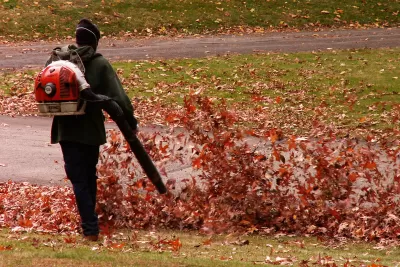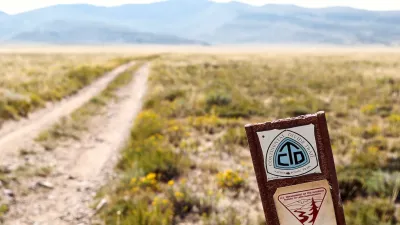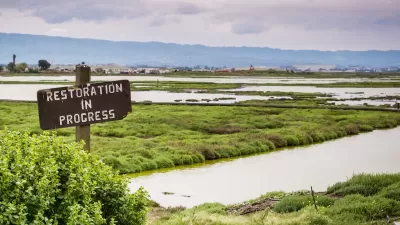Electric and battery-powered leaf blowers have a reduced impact on pollution and human health, but our lawn care practices continue to harm plant and animal habitats.

Dubbing them "mechanical locusts"––with apologies to locusts––that fill the air "with the stench of gasoline and death," Margaret Renkl argues for the abolition of gasoline-powered leafblowers, "the most maddening of all the maddening, environment-destroying tools of the American lawn-care industry."
With their outdated two-stroke engines, leaf blowers emit a massive amount of pollutants like carbon monoxide, smog-forming nitrous oxides, and carcinogenic hydrocarbons. "A 2011 study by Edmunds found that a two-stroke gasoline-powered leaf blower spewed out more pollution than a 6,200-pound Ford F-150 SVT Raptor pickup truck." Aside from pollutants, leaf blowers also emit noise "at levels that can cause tinnitus and hearing loss with long exposure," Renkl writes.
"This month, Gov. Gavin Newsom of California signed a new law making his the first state with plans to ban gas-powered lawn equipment along with other machines, like generators and pressure washers, that use gasoline-powered engines." Around the country, more than 100 cities have passed their own regulations prohibiting gas-powered leaf blowers, and the market share for electric and battery-operated tools is growing rapidly.
But even clean, quiet leaf blowers take a toll on biodiversity, says Renkl. "Leaf blowers, whether electric or gasoline-powered, dislodge the leaf litter that is so essential to insect life — the insect life that in turn is so essential to birds and other wildlife." To protect local ecosystems and biodiversity, Renkl notes, we should leave the leaves alone.
FULL STORY: The First Thing We Do, Let’s Kill All the Leaf Blowers

Alabama: Trump Terminates Settlements for Black Communities Harmed By Raw Sewage
Trump deemed the landmark civil rights agreement “illegal DEI and environmental justice policy.”

Planetizen Federal Action Tracker
A weekly monitor of how Trump’s orders and actions are impacting planners and planning in America.

The 120 Year Old Tiny Home Villages That Sheltered San Francisco’s Earthquake Refugees
More than a century ago, San Francisco mobilized to house thousands of residents displaced by the 1906 earthquake. Could their strategy offer a model for the present?

Ken Jennings Launches Transit Web Series
The Jeopardy champ wants you to ride public transit.

BLM To Rescind Public Lands Rule
The change will downgrade conservation, once again putting federal land at risk for mining and other extractive uses.

Indy Neighborhood Group Builds Temporary Multi-Use Path
Community members, aided in part by funding from the city, repurposed a vehicle lane to create a protected bike and pedestrian path for the summer season.
Urban Design for Planners 1: Software Tools
This six-course series explores essential urban design concepts using open source software and equips planners with the tools they need to participate fully in the urban design process.
Planning for Universal Design
Learn the tools for implementing Universal Design in planning regulations.
Clanton & Associates, Inc.
Jessamine County Fiscal Court
Institute for Housing and Urban Development Studies (IHS)
City of Grandview
Harvard GSD Executive Education
Toledo-Lucas County Plan Commissions
Salt Lake City
NYU Wagner Graduate School of Public Service





























